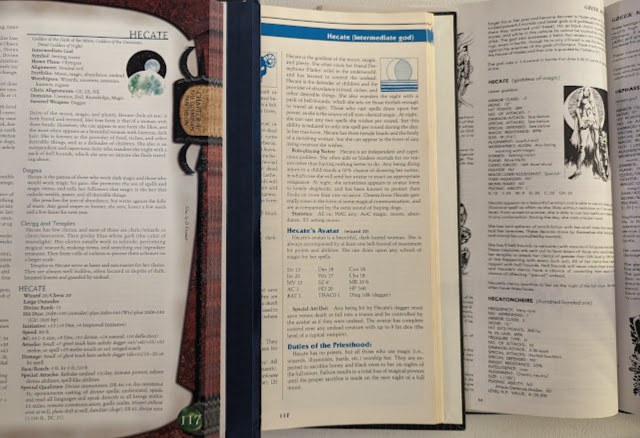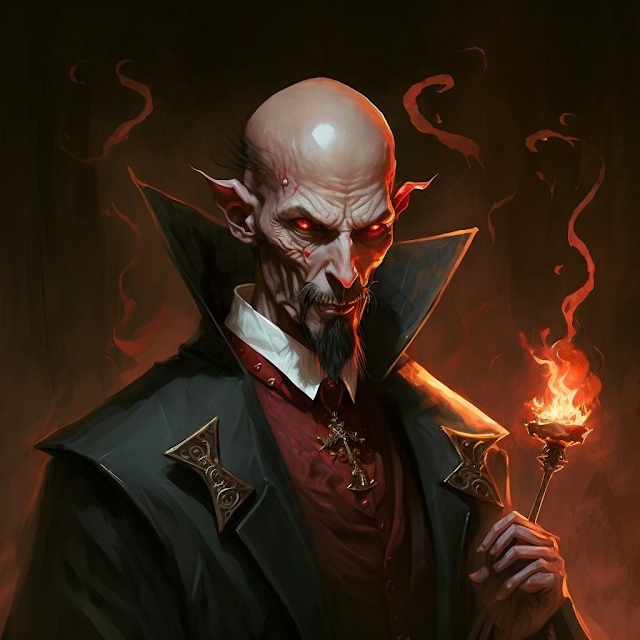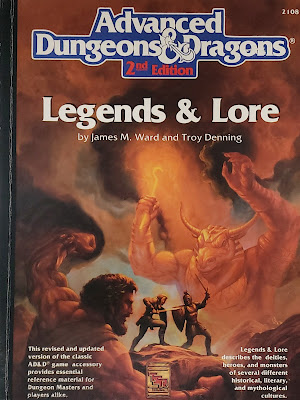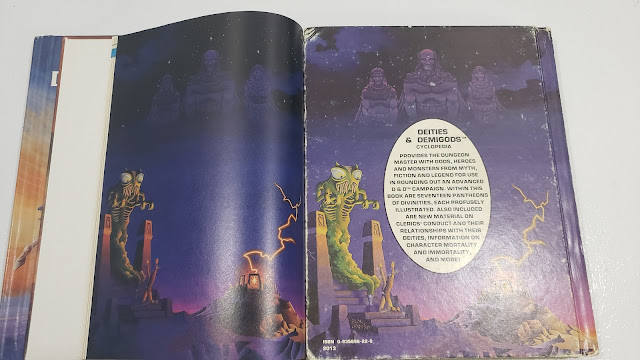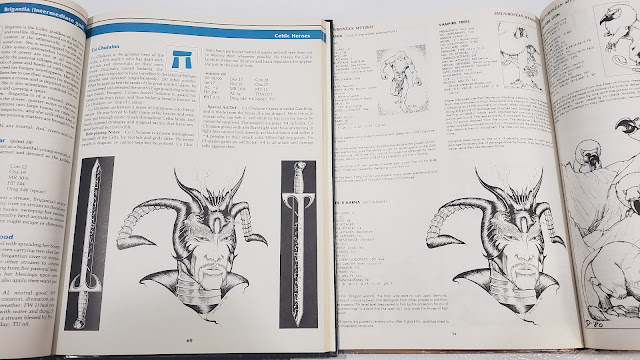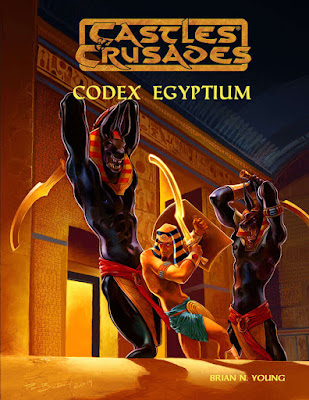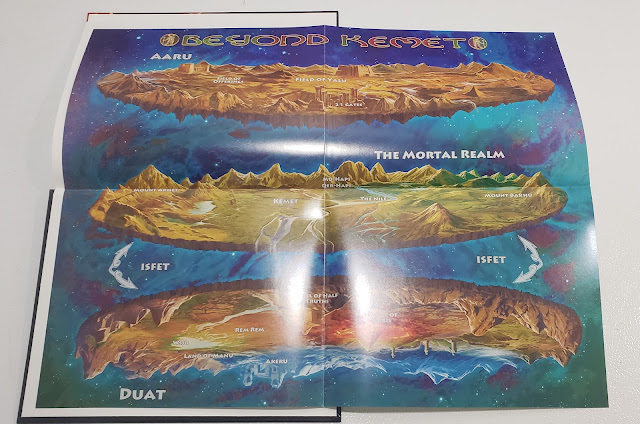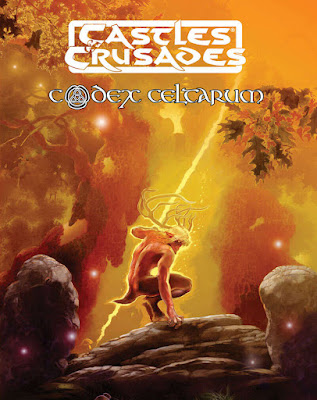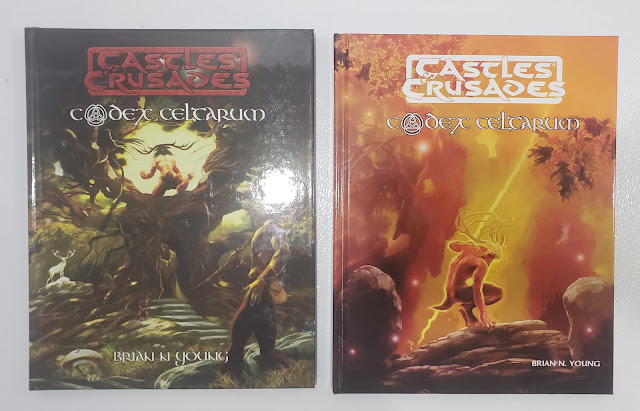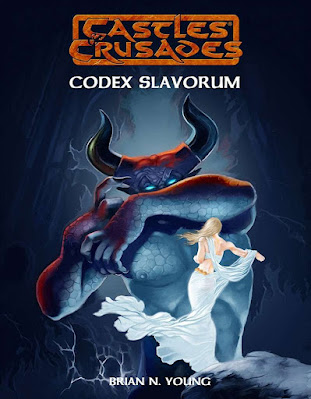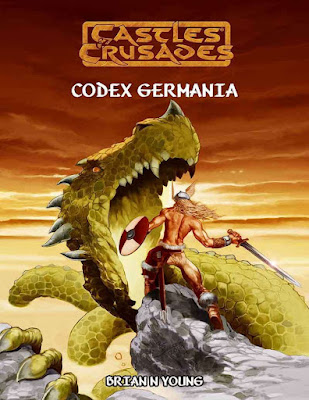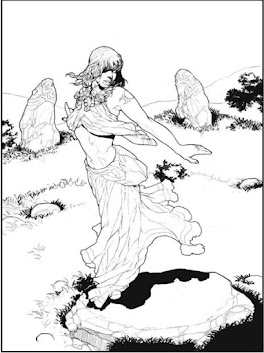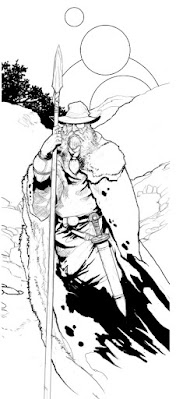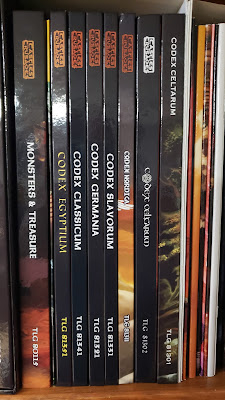A couple weeks back I posted a
One Man's God using the
AD&D 2nd Edition Legends & Lore. I mentioned at the time that this falls outside of the scope of the original concept of my OMG posts; that is can I take creatures from the Deities & Demigods and re-classify them as AD&D 1st Edition demons. Not historical demons, not mythological demons, but 1st Edition demons.
Since I have spent this week discussing Castles & Crusades I have often talked about how this game is the spiritual successor to AD&D. Do their books on gods also follow? Or to be more precise, can I do a One Man's God post on the C&C god books?
When it comes to discussing gods, demigods, and heroes Castles & Crusades is really second to none here. There Codex series, written by Brian Young, is some of the best-researched material for an RPG ever produced.
Gods and Demons in Castles & Crusades
You are not going to find stats for gods in C&C. They are not meant to be fought. There are however plenty of gods to encounter. I covered many of these in the various Codex books by Brian Young.
There is also the Gods & Legends book which I'll cover here and use as my basis for this One Man's God.
Demons are well covered in the Tome of the Unclean from Troll Lords. Tome of the Unclean follows pretty close to the AD&D standard demon with what I often refer to as "the Usual Suspects," so all the "Type" demons and succubi. So while I could more properly compare the C&C gods to the proper C&C demons, I think everything is close enough that I can continue with my original purpose of comparing these gods to the AD&D demons. If there are any differences they are so minor as not to be an issue. Besides. These are gods and demons we are talking about, there will always be exceptions to the rules.
Gods & Legends
For the purposes of this review, I am considering the PDF from DriveThruRPG.
PDF. 144 pages. Color covers, black & white interior art. Bookmarked and hyperlinked. Written by Davis Chenault with contributions by Steven Chenault, Brian Young, Jason Vey, and Todd Gray.
This book largely replaces the Of Gods & Monsters book from a few years back, though it is smaller in size, 144 pages vs 162. I say replaces, but this is a new set of work. The original Of Gods and Monsters was written by James Ward of Deities & Demigods fame. There are similar gods in both books but this new version is a rewrite of the older work with new entires to work better with the Codex series.
This book is divided into three(ish) large sections.
The Anvil of the Gods
This section covers how gods work in a Castles & Crusades game, how the Castle Keeper can play them, and how the characters can relate to them. This section also gives advice on designing a pantheon. Unlike the original Deities & Demigods that seemed to want to shy away from religion, this book acknowledges it and all the myriad combinations (within the space of this book) religions can take. The focus here though is not a religious academic text (and Troll Lords has at least two people, Young and Vey, on staff with graduate degrees in religious studies, literature, and history) but more on how these manifest and work in an RPG, and in Castles & Crusades in particular. To this end there is advice on how to run and play gods and how they should interact with the PCs.
Common deific abilities are defined with Greater, Lesser, and Demi-god statuses. Details are given to how the gods relate to the clerics and paladin classes, alignments, and other archetypes. Holy symbols and characters with divine traits are also covered. Divine traits include the healing touch.
Of the Gods
This is the largest section of the book, detail-wise. This covers what could properly be called the Gods of Aihrde, the Castles & Crusades campaign world. A brief overview of the basic deity characteristics is first. Up first are the human gods of Aihrde. This is the section that is most like the older Of Gods and Monsters book.

Some sections are the same as in the older book, many do look to be rewritten. The art is used from the older text but I do not see an issue with that. Many gods here get more text as well. Many of the Aihrde gods take cues and ideas from Earth gods. This is also not a big deal and in fact no different than the gods of the Forgotten Realms. In fact I am going to go out on a limb here and say the process to create these gods (from the Chenault home games no doubt) was very similar to what Ed himself did when he created the Forgotten Realms Gods. Maybe one day I need to go through this pantheon and the Forgotten Realms ones and see what gods they have in common. The obvious "Earth" gods are the All Father (Odin), The moon sisters (Diana, Artemis), Frafnog (Fáfnir, Midgard Serpent), Tefnut, Toth, Unklar (Chernbog), and Wenafar (Titania). Again, I like seeing this stuff. It immediately gives me a hook. If Frafnog is the god of dragons and there is a Fáfnir connection beyond the surface then there is a great reason why dwarves hate dragons more than just the Hobbit connection (which is of course drawn from the story of Fáfnir and The Ring of the Nibelung). There is deep religious animosity here. Is this what the Chenaults do in their home game? No idea, but this is what is happening in mine.
Following humans, we get the gods of the Dwarves, Elves, Halflings (LOVE the art of the halfling gods!), Gnomes, and then the humanoids (bugbears, gnolls, goblins, orcs, hobgoblins, lizardmen, giants, ogres, and trolls) there are even dragon deities, fey deities, and gods of mermen and sahuagin. It is a wide variety and shows some original ideas beyond what we typically think of in the Deities and Demigods, but not quite the level of detail as found in the very focused Forgotten Realms Demihuman Deities book.
All the Other Gods
This "section" is actually many sections, but they are mostly the same format. They cover the various gods and pantheons found in our world and are covered in detail by the Codex series. Where the Codecies give us a lot of details on the myths and stories of those pantheons, this section just covers game based stats. No stats as in hp and AC, but alignments, worshipers, granted attributes, preferred weapons and the like. No details on the gods themselves, for that you will need the Codies.
Covered are the gods of the Celts, Greeks, Egyptians, Germans, Norse, and Slavs.
Who should buy this book? Anyone playing Castles & Crusades and wants to go deep into the mythologies of Aihrde. Also, anyone that owns the Codies and wants more game content.
I also say this is a good book for the AD&D (first or second eds.) player/game master that wants a bit more detail on the gods in their Deities & Demigods/Legends & Lore books. Or who just want a different set of or more gods than they currently have. Indeed the title of the book, Gods & Legends, seems to state that it is a book with the AD&D books in mind.
One Man's God - The Demons of Aihrde
As I mentioned the Demons of Aihrde are already the Demons of AD&D. But what about the monsters and gods here in Gods & Legends? Let's see what we have here.
The obvious choices will be the Lesser Gods and the Demigods in terms of the power level near that of the Demon Princes. But I am not going to ignore the odd Greater God if they fit.
For the Aihrde human gods, Frafnog might fit the bill, though he is really powerful. Onduhl is the god of evil beings and has a strong Lucifer or Loki vibe to him. Unklar looks like a demon and has the Chernobog connection I mentioned above, but he seems more devil-like than demon-like.
The gods of the Dwarves, Halflings, and Gnomes do not have anyone. The Elves have Talahnatilia but that is something other than a demon or devil really.
It is not really to we get to the gods of the humanoids that we find good candidates.
Jarga the Bloodless is worshiped by many humanoid types (gnolls, kobolds, orcs). He is a lesser god and chaotic evil. He is a god of blood and battle. He might or might not be a demon, but he will certainly has their hatred of life. His plane is listed as The Wretched Plains, one of only three gods to claim this plane.
Bugbear gods here are Chaotic Evil. Hobgoblin gods are mostly Lawful Evil. This detail tracks with my own personal use of them. Bugbears are goblins with demonic ancestry and Hobgoblins are goblins with diabolic ancestry. So. If I am searching for demons I am going to look towards the Bugbears first. The bugbear gods are both greater gods and don't really fit the AD&D notion of demons. Same is true for the hobgoblins.
Gnolls have been long associated with demons in AD&D through Yeenoghu. Most of these gods are either too powerful (Greater) and/or Lawful Evil. Here is one of the issues of trying to apply the "rules" of one game on to another. They don't have to follow the same logic or premises.
Among the Goblins, Beerkzurd could be a demon, a powerful on to be sure. He is Lawful Evil, but he feels more Chaotic Evil really. He is also one of those gods people pray to not so much to get boons from him, but in order for him to leave you alone.
The Orc gods are quite war-like and many are Lawful Evil. They mostly seem like larger, more powerful versions of orcs. Which I guess can be said about most gods. They are just larger more powerful versions of the people that worship them.
Vasser of Lizardmen is another good choice. Lesser God, chaotic evil, looks like a demon. The same is all true for Grudznar of the Kobolds and Barg of the Trolls. In fact, all three do feel very demon-like. The lack of proper stats are really the only thing keeping me from deciding a definitive yes or no. Barg though is such an interesting being in a demented sort of way. I wish I had knew of him during my Troll Week a while back.
I am not considering the Dragon gods. They are really their own thing and many listed here do not fit the idea of a demon well. Yeah...I know I have both Tiâmat and Leviathan as eodemons. Plus I mentioned Frafnog above as a potential demon.
Same with the Fey. They are really their own thing. Though in my personal campaign the Fey do war against the demons. So it could be possible a "fallen fey" is a demon (fits what history did to them in our world). Not an evil fey. A "good" faerie still has more in common with an evil faerie than they do a demon.
Flathin of the Sahuagin also is a good choice as a demon. If we take the myths of Flathin and his sister Trimon it could be that Flathin was "cast down" as the patron of mermen and now is the patron of their evil counterparts, the Sahuagin. He is a chaotic evil lesser god and looks like a giant octopus with 10 tentacles (a decapus?). He grants little to his followers, save for what they get at their religious/war ceremonies.
Again. I might be extending my One Man's God to the point of breaking. Let this be a lesson in how scope creep or extending your theories beyond your testable hypotheses is a bad thing.
Other gods from Earth mythologies have been covered in previous postings of One Man's God.


